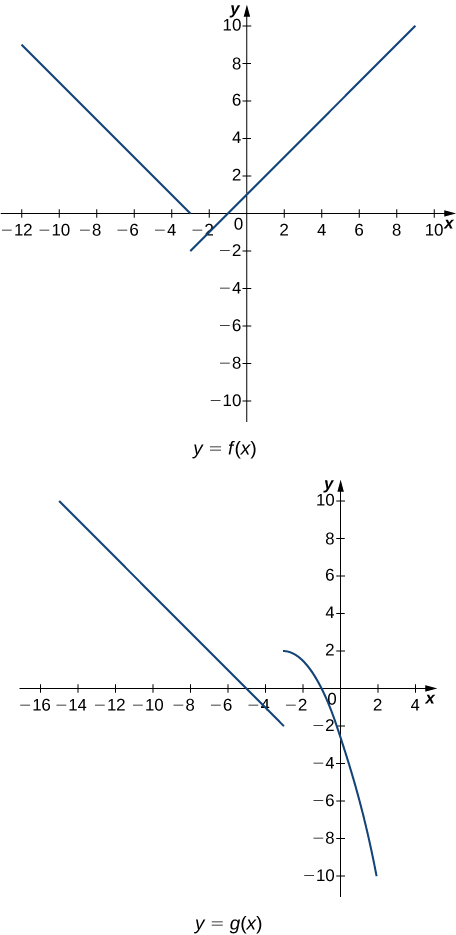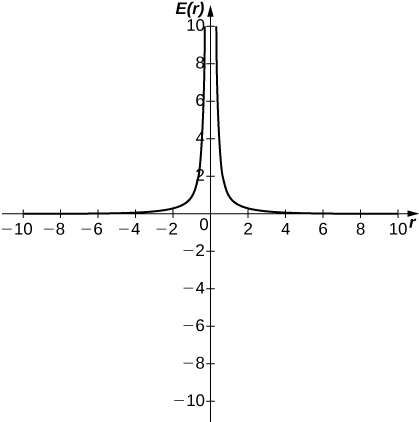In the following exercises (1-4), use the limit laws to evaluate each limit. Justify each step by indicating the appropriate limit law(s).
1. [latex]\underset{x\to 0}{\lim}(4x^2-2x+3)[/latex]
2. [latex]\underset{x\to 1}{\lim}\frac{x^3+3x^2+5}{4-7x}[/latex]
3. [latex]\underset{x\to -2}{\lim}\sqrt{x^2-6x+3}[/latex]
4. [latex]\underset{x\to -1}{\lim}(9x+1)^2[/latex]
In the following exercises (5-10), use direct substitution to evaluate each limit.
5. [latex]\underset{x\to 7}{\lim}x^2[/latex]
6. [latex]\underset{x\to -2}{\lim}(4x^2-1)[/latex]
7. [latex]\underset{x\to 0}{\lim}\dfrac{1}{1+ \sin x}[/latex]
8. [latex]\underset{x\to 2}{\lim}e^{2x-x^2}[/latex]
9. [latex]\underset{x\to 1}{\lim}\dfrac{2-7x}{x+6}[/latex]
10. [latex]\underset{x\to 3}{\lim}\ln e^{3x}[/latex]
In the following exercises (11-20), use direct substitution to show that each limit leads to the indeterminate form [latex]\frac{0}{0}[/latex]. Then, evaluate the limit.
11. [latex]\underset{x\to 4}{\lim}\dfrac{x^2-16}{x-4}[/latex]
12. [latex]\underset{x\to 2}{\lim}\dfrac{x-2}{x^2-2x}[/latex]
13. [latex]\underset{x\to 6}{\lim}\dfrac{3x-18}{2x-12}[/latex]
14. [latex]\underset{h\to 0}{\lim}\dfrac{(1+h)^2-1}{h}[/latex]
15. [latex]\underset{t\to 9}{\lim}\dfrac{t-9}{\sqrt{t}-3}[/latex]
16. [latex]\underset{h\to 0}{\lim}\dfrac{\frac{1}{a+h}-\frac{1}{a}}{h}[/latex], where [latex]a[/latex] is a real-valued constant
17. [latex]\underset{\theta \to \pi}{\lim}\dfrac{\sin \theta}{\tan \theta}[/latex]
18. [latex]\underset{x\to 1}{\lim}\dfrac{x^3-1}{x^2-1}[/latex]
19. [latex]\underset{x\to 1/2}{\lim}\dfrac{2x^2+3x-2}{2x-1}[/latex]
20. [latex]\underset{x\to -3}{\lim}\dfrac{\sqrt{x+4}-1}{x+3}[/latex]
In the following exercises (21-24), use direct substitution to obtain an undefined expression. Then, use the method of (Figure) to simplify the function to help determine the limit.
21. [latex]\underset{x\to -2^-}{\lim}\dfrac{2x^2+7x-4}{x^2+x-2}[/latex]
22. [latex]\underset{x\to -2^+}{\lim}\dfrac{2x^2+7x-4}{x^2+x-2}[/latex]
23. [latex]\underset{x\to 1^-}{\lim}\dfrac{2x^2+7x-4}{x^2+x-2}[/latex]
In the following exercises (25-32), assume that [latex]\underset{x\to 6}{\lim}f(x)=4, \, \underset{x\to 6}{\lim}g(x)=9[/latex], and [latex]\underset{x\to 6}{\lim}h(x)=6[/latex]. Use these three facts and the limit laws to evaluate each limit.
25. [latex]\underset{x\to 6}{\lim}2f(x)g(x)[/latex]
26. [latex]\underset{x\to 6}{\lim}\dfrac{g(x)-1}{f(x)}[/latex]
27. [latex]\underset{x\to 6}{\lim}(f(x)+\frac{1}{3}g(x))[/latex]
28. [latex]\underset{x\to 6}{\lim}\dfrac{(h(x))^3}{2}[/latex]
29. [latex]\underset{x\to 6}{\lim}\sqrt{g(x)-f(x)}[/latex]
30. [latex]\underset{x\to 6}{\lim}x \cdot h(x)[/latex]
31. [latex]\underset{x\to 6}{\lim}[(x+1)\cdot f(x)][/latex]
In the following exercises (33-35), use a calculator to draw the graph of each piecewise-defined function and study the graph to evaluate the given limits.
33. [T] [latex]f(x)=\begin{cases} x^2, & x \le 3 \\ x+4, & x > 3 \end{cases}[/latex]
- [latex]\underset{x\to 3^-}{\lim}f(x)[/latex]
- [latex]\underset{x\to 3^+}{\lim}f(x)[/latex]
34. [T] [latex]g(x)=\begin{cases} x^3 - 1, & x \le 0 \\ 1, & x > 0 \end{cases}[/latex]
- [latex]\underset{x\to 0^-}{\lim}g(x)[/latex]
- [latex]\underset{x\to 0^+}{\lim}g(x)[/latex]
35. [T] [latex]h(x)=\begin{cases} x^2-2x+1, & x < 2 \\ 3 - x, & x \ge 2 \end{cases}[/latex]
-
- [latex]\underset{x\to 2^-}{\lim}h(x)[/latex]
- [latex]\underset{x\to 2^+}{\lim}h(x)[/latex]
In the following exercises (36-43), use the graphs below and the limit laws to evaluate each limit.

36. [latex]\underset{x\to -3^+}{\lim}(f(x)+g(x))[/latex]
37. [latex]\underset{x\to -3^-}{\lim}(f(x)-3g(x))[/latex]
38. [latex]\underset{x\to 0}{\lim}\dfrac{f(x)g(x)}{3}[/latex]
39. [latex]\underset{x\to -5}{\lim}\dfrac{2+g(x)}{f(x)}[/latex]
40. [latex]\underset{x\to 1}{\lim}(f(x))^2[/latex]
41. [latex]\underset{x\to 1}{\lim}\sqrt[3]{f(x)-g(x)}[/latex]
42. [latex]\underset{x\to -7}{\lim}(x \cdot g(x))[/latex]
43. [latex]\underset{x\to -9}{\lim}[xf(x)+2g(x)][/latex]
For the following problems (44-46), evaluate the limit using the Squeeze Theorem. Use a calculator to graph the functions [latex]f(x), \, g(x)[/latex], and [latex]h(x)[/latex] when possible.
44. [T] True or False? If [latex]2x-1\le g(x)\le x^2-2x+3[/latex], then [latex]\underset{x\to 2}{\lim}g(x)=0[/latex].
45. [T] [latex]\underset{\theta \to 0}{\lim}\theta^2 \cos\left(\frac{1}{\theta}\right)[/latex]
46. [latex]\underset{x\to 0}{\lim}f(x)[/latex], where [latex]f(x)=\begin{cases} 0, & x \, \text{rational} \\ x^2, & x \, \text{irrational} \end{cases}[/latex]
47. [T] In physics, the magnitude of an electric field generated by a point charge at a distance [latex]r[/latex] in vacuum is governed by Coulomb’s law: [latex]E(r)=\large \frac{q}{4\pi \varepsilon_0 r^2}[/latex], where [latex]E[/latex] represents the magnitude of the electric field, [latex]q[/latex] is the charge of the particle, [latex]r[/latex] is the distance between the particle and where the strength of the field is measured, and [latex]\large \frac{1}{4\pi \varepsilon_0}[/latex] is Coulomb’s constant: [latex]8.988 \times 10^9 \, \text{N} \cdot \text{m}^2/\text{C}^2[/latex].
- Use a graphing calculator to graph [latex]E(r)[/latex] given that the charge of the particle is [latex]q=10^{-10}[/latex].
- Evaluate [latex]\underset{r\to 0^+}{\lim}E(r)[/latex]. What is the physical meaning of this quantity? Is it physically relevant? Why are you evaluating from the right?
48. [T] The density of an object is given by its mass divided by its volume: [latex]\rho =\dfrac{m}{V}[/latex].
- Use a calculator to plot the volume as a function of density [latex](V=\frac{m}{\rho})[/latex], assuming you are examining something of mass 8 kg ([latex]m=8[/latex]).
- Evaluate [latex]\underset{\rho \to 0^+}{\lim}V(\rho)[/latex] and explain the physical meaning.
Candela Citations
- Calculus Volume 1. Authored by: Gilbert Strang, Edwin (Jed) Herman. Provided by: OpenStax. Located at: https://openstax.org/details/books/calculus-volume-1. License: CC BY-NC-SA: Attribution-NonCommercial-ShareAlike. License Terms: Access for free at https://openstax.org/books/calculus-volume-1/pages/1-introduction


![The graph of three functions over the domain [-1,1], colored red, green, and blue as follows: red: theta^2, green: theta^2 * cos (1/theta), and blue: - (theta^2). The red and blue functions open upwards and downwards respectively as parabolas with vertices at the origin. The green function is trapped between the two.](https://s3-us-west-2.amazonaws.com/courses-images/wp-content/uploads/sites/2332/2018/01/11203457/CNX_Calc_Figure_02_03_206.jpg)

